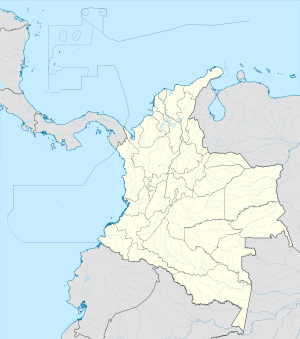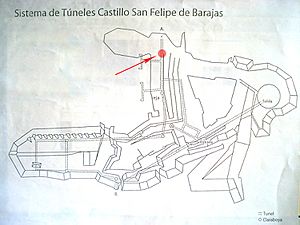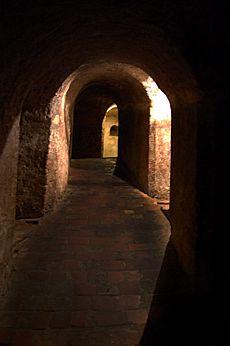Castillo San Felipe de Barajas facts for kids
Quick facts for kids Castillo San Felipe de Barajas |
|
|---|---|
| Cartagena, Colombia | |

Castillo San Felipe de Barajas
|
|
| Coordinates | 10°25′21″N 75°32′21″W / 10.4225°N 75.5392°W |
| Type | Bastion, Fortress |
| Site information | |
| Owner | Colombia |
| Controlled by | Colombia |
| Open to the public |
Yes |
| Site history | |
| Built | 1639–1767 |
| Built by | Antonio de Arévalo |
| In use | 1639–present |
| Materials | Stone |
| Battles/wars | Raid on Cartagena (1697) Battle of Cartagena de Indias (1741) |
| Garrison information | |
| Past commanders |
José de Herrera y Sotomayor (1739–41) |
The Castillo San Felipe de Barajas (which means San Felipe de Barajas Castle) is a huge, old fortress in Cartagena, Colombia. It was built a long time ago, starting in 1639. This castle sits on top of San Lázaro Hill. It was built in a super important spot to protect the city from enemies coming by land or sea. At first, it was called Castillo de San Lázaro. The Spanish built it during the colonial times. This strong castle was part of many battles between European countries from the late 1600s to the early 1800s.
Contents
History of the Castle
The main part of the fortress was finished by 1536. It was made even bigger between 1639 and 1657. The castle was built in a triangle shape on top of a hill. It had eight places for cannons, called batteries. About 200 soldiers and four gunners lived there. The castle was named to honor Philip IV of Spain, a king of Spain.
Battles and Changes
In 1697, during a big war called the War of the Grand Alliance, the castle was attacked. A French privateer, Baron de Pointis, took control of it.
The castle was fixed up in 1739 by José de Herrera y Sotomayor. Later, in 1741, a British admiral named Edward Vernon attacked the fortress. This was during an important fight called the Battle of Cartagena de Indias. But the Spanish admiral Blas de Lezo and his forces stopped Vernon. The castle was made even stronger in 1763 by Antonio de Arévalo.
During the Spanish American wars of independence around 1815, a large Spanish army arrived. They were led by Pablo Morillo. Cartagena fell to them in December. By May 1816, the Spanish had control of all of New Granada (which is now Colombia).
Exploring the Castle
The castle has many thick walls. They are wide at the bottom and get narrower at the top. This design made them very strong. The cannon areas and walls were built to protect each other. This made it almost impossible for attackers to take one part without taking the whole castle.
The castle is famous for its grand entrance. It also has a complex maze of tunnels. It is known as one of the strongest defense buildings made by the Spanish military. The highest point of the castle is about 41 meters (135 feet) above sea level.
Some important parts of the castle include the main triangular building. Around it are several cannon batteries. These batteries had 68 guns in total. They were all pointed away from the city to protect it. There were also special underground tunnels. These tunnels could be exploded to stop enemies from moving forward if they got inside.
Castle Today and Its Protection
For many years, the castle was not well cared for. After it was no longer used by the military, plants grew all over its walls. Dirt filled up the tunnels and trenches.
In 1984, UNESCO recognized the castle as a World Heritage Site. This means it's a very important place that should be protected. The historic center of Cartagena city was also included.
Since 1990, the castle has been used for special events. The Colombian government hosts important meetings and celebrations there. For example, it was used for the Summit of the Non-Aligned Movement in 1995. It also hosted the Summit of the Rio Group in 2000.
Today, the castle is open for visitors to explore. You can walk through some of its amazing tunnels and see its strong walls.
See also
 In Spanish: Castillo San Felipe de Barajas para niños
In Spanish: Castillo San Felipe de Barajas para niños
- List of colonial buildings in Cartagena, Colombia
- Spanish fortifications in America





